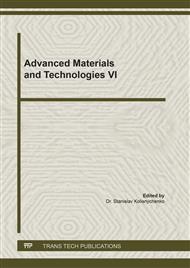[1]
N.A. Abdulla, Influence of plastic pour-in form on the mechanical behavior of concrete, J. Struct.19 (2019) 193-202.
DOI: 10.1016/j.istruc.2019.01.007
Google Scholar
[2]
A.M. Woldemariam, W.O. Oyawa, T. Nyomboi, Structural performance of UPVC confined concrete equivalent cylinders under axial compression loads, J. Build,9(82) (2019).
DOI: 10.3390/buildings9040082
Google Scholar
[3]
N.A. Abdulla, Concrete encased with engineering plastics, J. Civ. Eng. Const, 9(1) (2020) 31-41.
Google Scholar
[4]
A. Bandyopadhyay, A.K. Samanta, K.J. Michel Paul, Assessment of axial capacity of RC stub column confined with unplasticized polyvinyl chloride pipe, J. Ins. Eng. (India) Series A, 100(4) (2019) 535-546.
DOI: 10.1007/s40030-019-00397-5
Google Scholar
[5]
S.M. Askari, A. Khaloo, M.H. Borhani, M.S. Tale Masoule, Performance of polypropylene fiber reinforced concrete-filled UPVC tube columns under axial compression, Const. Build. Mater, (2020) 231117049.
DOI: 10.1016/j.conbuildmat.2019.117049
Google Scholar
[6]
N.A. Abdulla, Concrete with an outer plastic protective shell, SN Applied Sci, 2(6) (2020) https://doi.org/10.1007/s42452-020-2901-2.
Google Scholar
[7]
M.A. Raheemah, S.F. Resan, Experimental investigation of concrete columns enhanced by PVC Tubes, IOP Conf. Ser. Mater. Sci. Eng,(2019) 584 012047.
DOI: 10.1088/1757-899x/584/1/012047
Google Scholar
[8]
B. Babu, H. Paulose, Behavior of compound concrete-filled reinforced PVC tubes under compression, Inter. Res. J. Eng. Tech. (IRJET), 6(4) (2019) 2395-0072.
Google Scholar
[9]
A. Bandyopadhyay, K.K. Maurya, A.K. Samanta, Investigation on UPVC confined RC columns with recycled aggregate concrete using C&D waste, Structures 23 (2020) 279–288.
DOI: 10.1016/j.istruc.2019.09.015
Google Scholar
[10]
A.M. Woldemariam, W.O. Oyawa, T. Nyomboi, Behavior of concrete-filled single and double-skin UPVC tubular columns under axial compression loads, The Open Const. Build. Tech. J, 13 (2019) 164-177.
DOI: 10.2174/1874836801913010164
Google Scholar
[11]
N.A Abdulla, Using the Artificial Neural Network to Predict the Axial Strength and Strain of Concrete-filled Plastic Tube, J. Soft Comp. Civ. Eng, 4(2) (2020)63-84.
Google Scholar
[12]
A.N. Abdulla, Axial strength of short concrete-filled plastic tube, Structures 27 (2020) 1786-1800.
DOI: 10.1016/j.istruc.2020.07.061
Google Scholar
[13]
J. Xue, X. Zhao, F. Zhang, X. Ke, L. Ma, D. Xu, Investigation on seismic performance and shear strength of high-strength concrete-filled polyvinyl chloride tube short Columns, Struct. Design Tall Spec Build, (2019) 1674. doi.org/10.1002/tal.1674.
DOI: 10.1002/tal.1674
Google Scholar
[14]
N.A. Abdulla, The Behavior of Concrete-Filled Plastic Tube Specimens under Axial Load, Jordan J. Civ. Eng, 14 (1) (2020) 69-81.
Google Scholar
[15]
N.A. Abdulla, Mechanical behavior of slender composite columns under axial compression load, KSCE J. Civ. Eng, 24(1) (2020) 208-218.
DOI: 10.1007/s12205-020-0669-y
Google Scholar
[16]
American Concrete Institute (ACI), Requirements for Structural Concrete, ACI 318R-14, Farmington Hills, MI, (2014).
Google Scholar
[17]
A.M. Woldemariam, W.O. Oyawa, N.T. Timothy, Reliability assessment of axially loaded uPVC tube confined reinforced concrete columns, Structures, 23 (2020) 529–538.
DOI: 10.1016/j.istruc.2019.11.009
Google Scholar
[18]
F. Yu, D. Li, D. Niu, D. Zhu, Z. Kong, N. Zhang, Y. Fang, A model for ultimate bearing capacity of PVC-CFRP confined concrete column with reinforced concrete beam joint under axial compression, Const. Build. Mater, 214 (2019) 668–676.
DOI: 10.1016/j.conbuildmat.2019.04.131
Google Scholar
[19]
H. Zhang, M.N.S Hadi, Geogrid-confined pervious geopolymer concrete piles with FRP-PVC confined concrete core: Concept and behavior, Const. Build. Mater, 211 (2019) 12–25.
DOI: 10.1016/j.conbuildmat.2019.03.231
Google Scholar
[20]
C. Gao, L. Huang, L. Yan, R. Jin, B. Kasal, Strength and ductility improvement of recycled aggregate concrete by polyester FRP-PVC tube confinement, Composites Part B,162 (2019) 178–197.
DOI: 10.1016/j.compositesb.2018.10.102
Google Scholar
[21]
F. Yua, N. Zhang, D. Niu, Z. Kong, D. Zhu, S. Wang, Y. Fang, Strain analysis of PVC-CFRP confined concrete column with ring beam joint under axial compression, Composite Structures, 224 (2019) 111012.
DOI: 10.1016/j.compstruct.2019.111012
Google Scholar
[22]
V. Yazici, M.N.S. Hadi, Normalized Confinement Stiffness Approach for Modeling FRP-Confined Concrete, J. Compos. Constr, 16 (2012) 520-528.
DOI: 10.1061/(asce)cc.1943-5614.0000283
Google Scholar
[23]
ASTMD638, Standard Test Method for Tensile Properties of Plastics, ASTM International, West Conshohocken, PA, (2008).
Google Scholar
[24]
F.E. Richart, A. Brandtzaeg, R.L. Brown, A study of the failure of concrete under combined compressive stresses, Bulletin 185, Univ. of Illinois Engineering Experimental Station, Urbana-Champaign, IL, (1928).
Google Scholar
[25]
L.D. Lorenzis, R. Tepfers, A comparative study of models on confinement of concrete cylinders with FRP composites, Rep. No. 01:04, Dept. of Build. Materials, Chalmers Univ. Tech, Gothenburg, Sweden, (2001).
Google Scholar
[26]
American Concrete Institute (ACI), Guide for the design and construction of externally bonded FRP systems for strengthening concrete structures, 440.2R-08, Farmington Hills, MI, (2008).
DOI: 10.14359/51700867
Google Scholar
[27]
L. Lam, J.G. Teng, Design-oriented stress-strain model for FRP-confined concrete, Constr. Build. Mater, 17(6–7) (2003) 471–489.
DOI: 10.1016/s0950-0618(03)00045-x
Google Scholar
[28]
L. Lam, J.G. Teng, Design-oriented stress-strain model for FRP-confined concrete in rectangular columns, J. Reinf. Plast. Compos, 22(13) (2003) 1149–1186.
DOI: 10.1177/0731684403035429
Google Scholar
[29]
J. Lu, Y. Tian, J. Chen, C.Y. Zhu, F.Y. Zeng, J.C. Yang, W. Wang, Experimental Study on CFRP-PVC Confined RAC under Axial, Compression, Solid State Phenomena ISSN 1662-9779, 294 (2019) 143-149,.
DOI: 10.4028/www.scientific.net/ssp.294.143
Google Scholar
[30]
J. B. Mander, M.J.N. Priestley, R. Park, Theoretical stress-strain model for confined concrete, J. Struct. Eng, 114(8) (1988) 1804–1826.
DOI: 10.1061/(asce)0733-9445(1988)114:8(1804)
Google Scholar
[31]
L. Lam, J.G. Teng, Design-oriented stress-strain model for FRP-confined concrete, Constr. Build. Mater, 17(6–7) (2003) 471–489.
DOI: 10.1016/s0950-0618(03)00045-x
Google Scholar
[32]
A. Mirmiran, Analytical and experimental investigation of reinforced concrete columns encased in fiber glass tubular jackets and use of fiber jacket for pile splicing, in Contract no. B-9135.FloridaDepartment of Transport: Tallahassee, FL; (1996).
Google Scholar
[33]
G. Wu, Z.T. Lu, Z.S. Wu, Strength and ductility of concrete cylinders confined with FRP composites, Constr. Build. Mater, 20(3) (2006) 134–48.
DOI: 10.1016/j.conbuildmat.2005.01.022
Google Scholar


